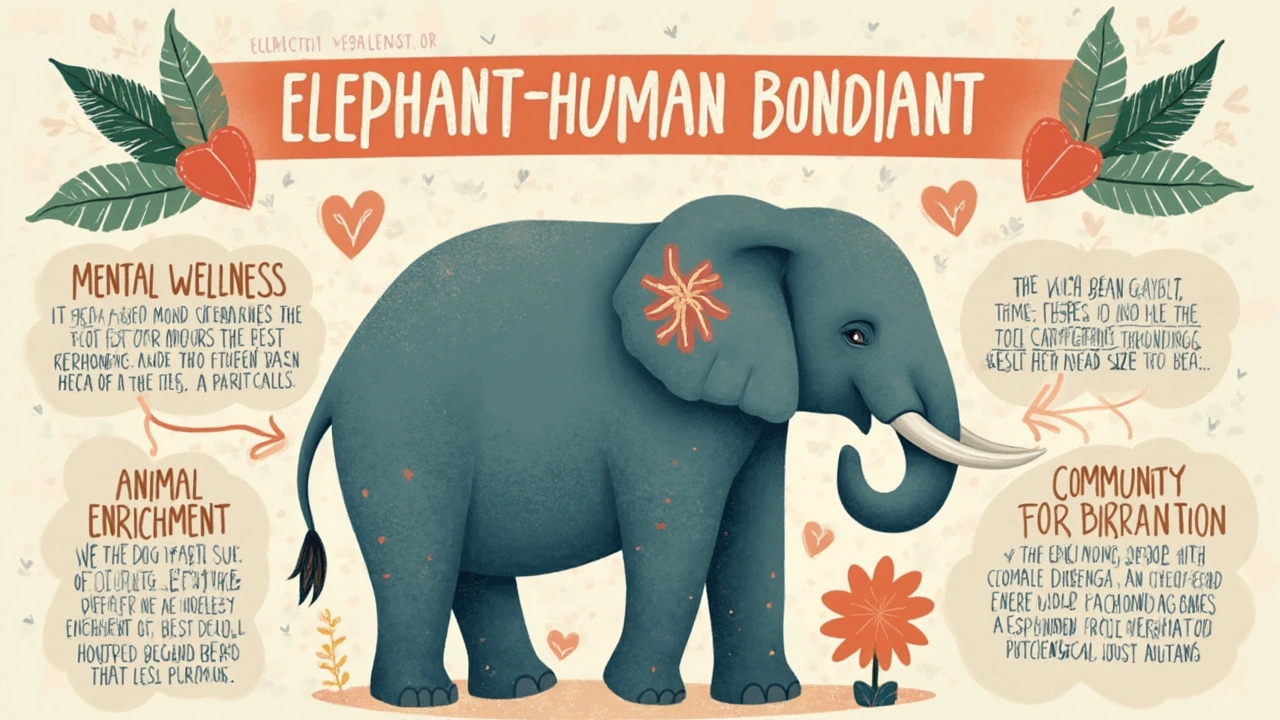Elephant Massage: Exploring the Unique Practice and Its Benefits
 Jul, 1 2025
Jul, 1 2025
Thailand's jungles hum with ancient secrets, but here’s one you probably didn’t see coming: elephants, those massive, wrinkled wonders of the wild, love a good massage. That’s right—elephant massage isn’t just a sideshow for tourists. It’s a real practice, mixing care, culture, and gentle elephant-sized touch. Imagine watching an elephant’s trunk kneading another’s back, or seeing a keeper rubbing soothing mud into tough, grey skin, and you get the idea: these guys know how to unwind. But why do elephants need massages? How does it help them? And how on earth do you massage something as big as a pickup truck? Welcome to a world where pampering knows no bounds.
The Origins of Elephant Massage: Ancient Care Meets Modern Curiosity
Let’s clear up something right away: this isn’t just a recent social media stunt. People have been taking care of elephants for thousands of years, especially in countries like Thailand, India, and Sri Lanka. Mahouts—those experienced handlers who basically spend their lives with these animals—know everything about their charges, from favorite snacks (watermelon is a hit) to hidden ticklish spots on their bellies.
It didn’t start as “massage.” It started as survival. Elephants working in the logging industry or temples took a real beating—literally hauling wood, giving rides, marching in the heat all day. Like any athlete, their joints wore out, their muscles got sore. Early caretakers noticed swollen joints, limping, and reduced appetite. Out of necessity, mahouts began rubbing ointments into joints, scrubbing their thick skin, and gently stretching elephant legs—kind of like a cross between physical therapy and spa treatment.
This evolved into a more structured form of animal wellness. By the late 20th century, animal rights campaigns put pressure on traditional industries, and tourist camps repositioned themselves as sanctuaries. Marketing “elephant massage” started to attract curious travelers, blending animal welfare with something humans understood: pampering. You’d be surprised how many tourists now pay to watch—or receive—a light-footed ‘massage’ from an elephant’s trunk (don’t worry, they’re gentle…most of the time).
But the real magic happens when elephants get their massages, not humans. Handlers use wooden sticks to rub behind the ears—elephants absolutely love this spot, thanks to thin skin and tons of nerve endings. They dip natural mud onto sensitive skin patches, easing sunburn and bug bites. There’s even an ancient Indian tradition, Gaja Shastra, that describes hand movements to stimulate elephant blood flow and calm nervous beasts before ceremonial events. It’s not gimmickry; it’s tradition rooted in observation, passed down generation to generation.
Why Elephants Need Massage: Biology and Behavior
Think elephants are just lumbering tanks with rough hides and no need for self-care? Think again. Under all that leathery armor, elephants face more issues than you’d expect. A healthy adult elephant weighs anywhere from 6,000 to 14,000 pounds. Their legs support as much as a city bus. Long days on hard ground, endless foraging, and—especially in captivity—way less roaming than they evolved for, all spell trouble for joints, feet, and muscles.
Elephant feet are miracles of evolution: thick fatty pads, six ‘toes’ hidden under wrinkled skin, lots of intricate nerve endings. Yet, these wonders are surprisingly delicate. Poor foot care leads to cracking, infections, arthritis, and even fatal immune problems. Massage, done right, boosts blood flow, relieves pressure, and helps keep the skin flexible. In temple elephants in India, caretakers discovered that regular leg and foot massages cut down on abscesses by more than half—an enormous improvement for a population constantly battling foot rot.
Let’s not forget behavior. Elephants, wild or captive, deal with anxiety and boredom. These are social creatures, every bit as emotional as we are—maybe more. In sanctuaries where daily routines are repetitive, elephants often develop ‘stereotypic’ behaviors: swaying, head-bobbing, or compulsively pacing. Massage gives them physical relief, but it’s also a mental break. The touch, the attention, and even the anticipation of a cool mud rub provide real relaxation, lowering stress hormone levels (cortisol) just like in humans. Researchers at Chiang Mai University famously demonstrated that elephants receiving weekly massage sessions showed far fewer stress signals and were more sociable with both humans and herd-mates. Kind of like how we feel after a killer massage session on a Friday night.
So, do elephants “like” massages? Their reactions say it all: rumbling purrs, flapping ears, heavy eyes, lazy tail swings—pure bliss. Baby elephants clamber over each other trying to get their turn under the handler’s skilled hands or a buddy’s trunk. They even have favorites, with certain handlers drawing more affection, trumpeting, or snuggling than others. It’s not just about soothing aches; it’s powerful bonding and communication.

How Elephant Massage Is Done: Techniques, Tools, and Safety
You can’t just slap a little coconut oil on a ten-ton animal and call it a day. Proper elephant massage involves traditional skills, a deep understanding of anatomy, and, let’s face it, a strong stomach for getting covered in mud, hay, and elephant slobber. Mahouts and trained veterinarians typically start by talking softly and letting the elephant know what’s coming—think how you’d warn a child before dunking them in a pool.
Hand techniques range from circular rubbing on soft skin (trunk, ears, and underarms) to careful pressure rolling along muscles in the legs and back. For hard-to-reach places, caretakers use simple tools: smooth wooden sticks for the feet and legs, stone pestles for tougher back muscles, and even crafted brushes for exfoliating dry skin. The trick is learning the animal’s thresholds—too soft and it tickles, too rough and the elephant stomps away or trunkswats you on the head.
There are some wild tools in the mix, too. In some Thai sanctuaries, caretakers use “massage poles,” long staffs wrapped in soft cloth, to roll across a reclining elephant’s side. In India, cooled turmeric paste is used as a warming muscle rub, fighting infection and drawing out swelling from bug bites.
Safety matters, both for humans and elephants. No one gets between an elephant and their favorite mahout, and keep in mind that even the gentlest momma can pop a soccer ball with her foot, so handlers always watch for subtle signs of mood change: rapid ear twitching, sudden silence, shifting weight. Massage sessions max out at 20-30 minutes, sometimes broken up by quick soaks in a river or sand baths—elephants love a good dusting post-massage.
It’s not a spa day on a table, obviously. Most massages are done while the elephant lies on one side in a shaded patch, legs splayed out, eyes blinking in slow time. The best sign of success? That contented rumble, like a purring cat with a foghorn.
The Surprising Benefits of Elephant Massage
Massaging an elephant is about way more than making them feel good for a few minutes. The benefits stack up fast, from hard physical science to emotional wellness. Take joint health: regular massage increases blood flow to thick-skinned areas, speeds healing after minor injuries, and keeps swelling at bay. Foot and leg issues, which are top killers in captive elephants, drop dramatically in herds where massage is regular and paired with foot soaks and trimming.
But it doesn't stop there. Elephants with chronic skin problems like dermatitis or fungal infections get real relief from mud application massages blended with anti-fungal herbs. The mud cools hot skin, and handlers physically remove parasites by scraping. Ever seen an elephant standing stock still, droopy-eyed, as a mud-coated stick scrapes behind her ear? That’s trust in action—and relief from nagging itches.
Behaviorally, massage is a game-changer. Boredom-driven stereotypes almost vanish when elephants look forward to regular social touch. Herds with frequent massage sessions display more social grooming, less aggression, and even more playful trunk wrestling. Handlers in Sri Lanka report that previously shy, anxious animals become calmer and bond better with both humans and herd-mates after a few months of massage. It’s as vital as any enrichment activity, right up there with new pools, enrichment toys, and varied diets.
For aging elephants or those retired from labor, massage can literally add years to their lives. In a 2022 study at a Chiang Rai sanctuary, retired work elephants getting thrice-weekly massage showed slower declines in muscle mass, more mobility, and fewer chronic aches compared to a non-massaged group. It’s the difference between graceful old age and early decline.
And there’s a bonus benefit for handlers too. The hands-on care builds deep bonds, mutual trust, and keeps mahouts attuned to early warning signs of sickness or injury. Good caretakers spot tiny changes while massaging—heat, swelling, cuts—sometimes days before symptoms turn serious.

Experiencing Elephant Massage Ethically: Tips for Visitors and Enthusiasts
Seeing—or participating in—an elephant massage might be on your bucket list now. But watch out: not all elephant experiences are created equal. If you visit an elephant camp or sanctuary, research is key. Ethical sanctuaries put elephant welfare first, not tourist entertainment. Red flags? Elephants performing unnatural tricks, carrying tourists on backs for long rides, or living in cramped, unstimulating enclosures.
The best camps let you observe (not disturb) professional handlers at work. Some offer educational tours, letting you see firsthand how elephant massage supports animal health and happiness. A few might invite guests to participate in simple, safe tasks—perhaps washing down an elephant after a mud massage or helping collect soothing herbs for rubs. Don’t expect to receive a ‘massage’ from an elephant’s trunk unless you’re ready for a very snotty surprise. And don’t trust any place pushing elephant massage gimmicks for Instagram photos over actual animal care.
If you want to try elephant massage yourself, always follow a trained handler’s lead. Approach quietly, avoid sudden moves, and trust that the elephant knows her own boundaries. Listen for those delightfully deep rumbles and watch for signs of relaxation: drooped ears, low tail, soft feet. Stand back if the elephant seems agitated or distracted, and always let her move away at her pace.
Support sanctuaries focused on rescue, rehabilitation, and responsible education. Your entry fee or donation helps fund professional care, including expert massage, veterinary medicine, and habitat improvements. By choosing your experience thoughtfully, you support a world where elephants get the health care—and yes, the pampering—they deserve.
Next time you hear an elephant’s deep, rolling call from the jungle, remember: somewhere out there, a twelve-thousand-pound giant is laying back, closing her eyes, and letting all her aches melt away under the hands or trunk of a trusted friend. And if you’re ever lucky enough to see it for yourself, you’ll know there’s more to this ancient bond than meets the eye.
